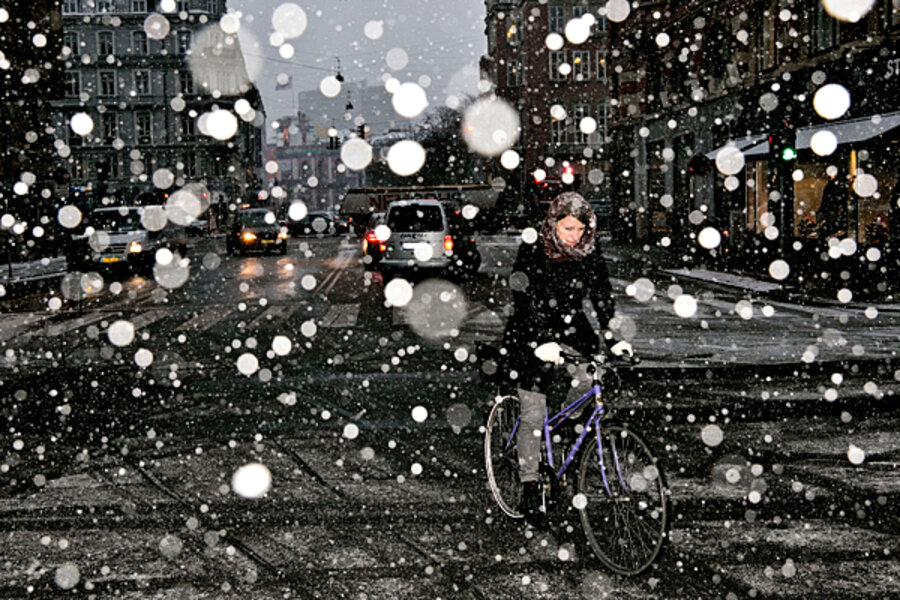Inuit Greenlanders face chilly life in Denmark
Loading...
| Copenhagen, Denmark
A tourist visiting Denmark’s capital of Copenhagen for the first time might be taken aback by the number of what appear to be Native Americans among the sea of fair-haired Danes on the streets. But that is exactly what they’ll find.
The people in question are Greenlanders. Thousands of Inuit people have come from the Arctic island, which became a Danish colony almost 200 years ago, and now live in this small Scandinavian country. But despite having long ties with – and being full citizens of – Denmark, many Greenlanders find themselves marginalized in Danish society, due to both their own culture shock and stereotyping by native Danes.
Greenlanders are related genetically and linguistically to other indigenous inhabitants of northern latitudes in Canada, Russia, and Alaska. Norse settlers began coming to Greenland around the end of the first millennium, though these European outposts came to an end in the 1500s. Greenland became a Danish colony in 1814, and was granted home rule in 1979.
In 2008, Greenlanders voted for greater autonomy, leaving the Danish government in charge only of its foreign affairs, defense, and finances. Greenland, the world’s largest island, is also the most sparsely populated country, with 56,000 inhabitants on its roughly 830,000 square miles (slightly more than three times the size of Texas), much of which is covered with a massive ice sheet.
Greenlanders began to settle in Denmark in the 1950s, and approximately 18,500 Greenlanders live there now.
A challenging transition
Nivi Christensen of the Greenlandic House, an NGO and cultural center in Copenhagen that provides information to the public and helps Greenlanders adjust to life in Denmark, says things did not get off to an auspicious start.
“Some of the first Greenlanders to make their way to Denmark were those suffering mental and physical infirmities, because there was a lack of facilities to deal with such issues in Greenland,” she explains. “Of course, those with mental illness had difficulty adjusting and many fell through the cracks.”
And for some Greenlanders arriving in a metropolis like Copenhagen, culture shock is an issue. Culturally, Greenlanders are known to be soft spoken and not likely to actively seek help, perhaps part of the reason why there are now said to be around two hundred who are homeless in Copenhagen.
“Greenlanders come from small settlements where everyone knows each other. Coming to a big, bustling city like Copenhagen can be challenging,” says Ms. Christensen, who herself has Greenlander and Danish heritage. “Much of our counseling work addresses issues simply of loneliness and estrangement.”
Cultural misunderstandings
But part of the problem of integration arises from large-scale misconceptions about Greenlanders and Greenland among the Danish public. Despite perceived differences between Greenlanders and Europeans, there has been more mixing between the two than is commonly supposed, says Søren Thalund of the Greenlandic House.
“Genetic studies in southern Greenland show that there is a mixed heritage with Celtic and Norse elements," he says. "In the north there is a mixture of Dutch, German, and Scottish with the Greenlanders from the whaling fleets that used to come there.”
And Christensen notes that some of the misunderstandings border on the comical. “People have seriously asked me if Greenlanders live in igloos and travel only by dogsled,” she says. “Greenland has modern infrastructure, travel by plane between towns, Internet available all over and fresh fruits and vegetables in the shops.”
Though some misunderstandings border on humorous, others are more harmful. A poll of Danish citizens last September by the tourism company Visit Greenland revealed that negative stereotypes of Greenlanders persist. Of 1,017 Danes questioned, 40 percent associated Greenlanders with binge drinking, substance abuse, and social problems. And 43 percent thought that over half of Greenlanders were on public assistance – the real number is closer to 16 percent.
“Native-born Danes actually drink more than Greenlanders,” says Christensen. “And the numbers of indigent or dependent are comparable. Greenlanders work in all walks of life and live all over Denmark in big cities and small towns.”
Søren Thuesen, a professor in the department of cross-cultural and regional studies at the University of Copenhagen who studies Greenlander issues agrees that integration has been largely successful. “The vast majority of Greenlanders are well integrated. A minority is not and as Danish citizens they are entitled to assistance from the social authorities.”
Still Thuesen acknowledges that antagonisms and chauvinism persist. “There is no doubt that most Greenlanders, as well as immigrants from other countries, experience prejudices on many levels in Denmark.”





